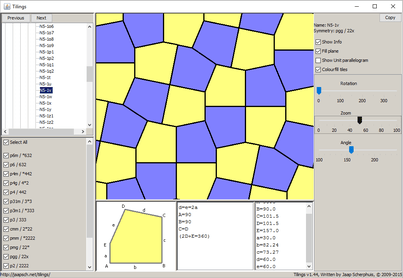
On these pages I will show some of my research into tiling patterns.
I have written a Tiling Viewer that allows you to see most of the tilings that I found in my research. I used it to generate all the pictures on this page. Click the link for more information and to download it.
It is well known that any triangle can tile the plane, as can any quadrangle, convex or not.
The situation with pentagons is much more complicated. A regular pentagon does not tile the plane, but various non-regular convex pentagons do. In 1975 Martin Gardner wrote an article in Scientific American, reporting the results of Richard B. Kershner about which types of convex pentagons can tile the plane [MG]. Richard had attempted to enumerate them, and thought that his list of 8 types was complete until in a reaction to Gardner's article Richard E. James III wrote in with another tilable convex pentagon (now known as type 10). Marjorie Rice [MR] found four others which she also sent to Gardner (types 9, 11-13), bringing the total to 13. A further type was found by Rolf Stein in 1985 (type 14).
That is how the situation stayed for a long time. The uncertainty about whether the list of 14 pentagon types is complete inspired me to do my own research into tilings. In 2010 I wrote a program that generates all possible tilings that use k copies of a single polygon tile as its fundamental unit. With this program I tried to find new types of tilable convex pentagons, but that quest was not successful. It nevertheless generated many fascinating tilings, some that I think have not been seen before, most of which I have incorporated into the Tiling Viewer applet. My programs were too slow and generated too many duplicates and false solutions to make much headway when k is 3 or more.
In 2015 a 15th convex pentagon type was found by Casey Mann, Jennifer McLoud-Mann and David Von Derau [MMD]. It turned out that they had used approximately the same methods as I had, except more efficiently and with more proofs. In May 2017, Michaël Rao [MR2] announced a proof that the list of 15 types is complete. The proof relies on a computer program to first enumerate a finite number of cases which cover all possible tilings, and then eliminate any that are not one of the 15 known types. The program's proof has now been verified by Thomas Hales so it is likely to be correct.
Isohedral tilings with convex polygons are well-studied and can be found in [G+S] and [TM]. There are:
14 isohedral tilings with a triangle tile
56 isohedral tilings with a quadrangle tile
24 isohedral tilings with a convex pentagon tile
13 isohedral tilings with a convex hexagon tile
Convex n-gons with n>6 cannot tile the plane. This is because for n>6, the average of the tile's angles is more than 120 degrees, but if at every vertex in the tiling at least three or more tiles meet then the average angle must be 120 degrees or less. Therefore there are vertices in the tiling where only two tiles meet, and either one of the angles is more than 180, or they are both equal to 180. So either the tile is not convex, or it has redundant vertices. This is also fairly easy to prove by using Euler's characteristic.
All the isohedral tilings with a convex tile can be found in the Tiling Viewer applet. Some of them are special cases of others, where the settings are such that the tiling has extra symmetries, and those have not all been implemented separately.
Most 2-isohedral tilings have a fundamental unit consisting of two tiles, one from each isohedrality class. In the Tiling Viewer applet the tiling will then have an equal amount of the two colours. There are also some rare cases of 2-isohedral tilings where the two types of tile occur in a 2:1 ratio. In these cases the fundamental unit consists of 3 tiles, and has an extra mirror symmetry that maps two of the tiles to each other. My programs only find these when searching for 3-isohedral tilings, sometimes as a special case of a more general 3-isohedral tiling.
My search program has exhaustively generated all of the tilings for which the fundamental unit consists of two identical convex polygons, and assuming no mistakes or oversights, the Tiling Viewer applet contains a complete set of these types of tiling.
No new types of tilable convex pentagon were found. Most of the tilings used type 1 pentagons, seven of type 2, one of type 4, and there is one alternative way to tile the type 6 pentagon tile.
I have not yet searched for all 3-isohedral tilings, as that will take a lot of time. I have therefore limited myself to the edge-to-edge 3-isohedral tilings for triangles, quadrangles and pentagons, all of which have been implemented in the Tiling Viewer applet. Nevertheless, some tilings that are not edge-to-edge have been implemented too.
Searching for k-isohedral tilings with k>3 is probably infeasible with my current search program. I did start it searching for edge-to-edge 4-isohedral convex pentagon tilings, and it found the following neat one using a type 8 pentagon tile.
I have made a separate page for the tilings I've found that have non-convex tiles.
Here are the two articles I wrote as exchange gifts for the Gathering for Gardner conference.
My G4G10 exchange gift paper (2661 KB): Similar to the contents of this page.
My G4G11 exchange gift paper (1034 KB): Some geometry problems arising from tilings.
In 2018 I gave a short talk about tilings at G4G13.
Video: Recent developments in pentagonal tilings. I used these slides (19,463 KB).
Here are some interesting links about these kinds of tilings:
Books:
Written by Jaap Scherphuis, tilings a t jaapsch d o t net.